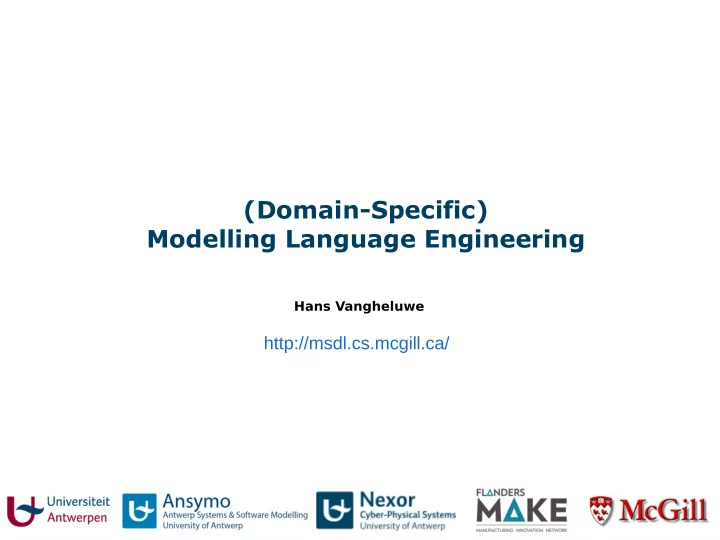

(Domain-Specific) Modelling Language Engineering Hans Vangheluwe http://msdl.cs.mcgill.ca/
at the most appropriate level(s) of abstraction at the most appropriate level(s) of abstraction using the most appropriate formalism(s) using the most appropriate formalism(s) explicitly modelling processes explicitly modelling processes Enabler: (domain-specific) modelling language engineering Enabler: (domain-specific) modelling language engineering including model transformation including model transformation
WEST: modelling biological wastewater treatment. Henk Vanhooren, Jurgen Meirlaen, Youri Amerlinck, Filip Claeys, Hans Vangheluwe and Peter A.Vanrolleghem. Journal of Hydroinformatics 5 (2003) 27-50
http://www.mikebydhi.com/products/west
Nagy, Danil, Damon Lau, John Locke, Jim Stoddart, Lorenzo Villaggi, Ray Wang, Dale Zhao and David Benjamin. “Project Discover : An Applicatjon of Generatjve Design for Architectural Space Planning.” (2017).
“fjtness”
generated (evolutionary – e.g., Genetic Algorithms)
“fitness” evaluation for each of the generated designs
Model Features
MPM
Model Validity Range www.centuryspring.com
Experimental (Validity) Frame Joachim Denil, Stefan Klikovits, Pieter J. Mosterman, Antonio Vallecillo, and Hans Vangheluwe. The experiment model and validity frame in M&S. In Proceedings of the 2017 Symposium on Theory of Modeling and Simulation - DEVS , TMS/DEVS '17, part of the Spring Simulation Multi-Conference, pages 1085 – 1096. Society for Computer Simulation International, April 2017.
T oken Models
Rôles a Model may Play
Ontological vs. Linguistic Conformance/Instatiation
Linguistic Conformance: morphism
MetaDepth model <--> meta-model http://metadepth.org/ strict Model PetriNets@1 { load "PetriNets" abstract Node NamedElement{ PetriNets Test{ name : String {id}; Place p0{name="p0"; tokens=2;} } Place p1{name="p1"; tokens=0;} Node Place : NamedElement { Place p2{name="p2"; tokens=2;} tokens : int = 0; Transition t1{name="t1";} outTrans : Transition[*] {ordered,unique}; ArcPT pt0(p0,t1){weight=1;} inTrans : Transition[*] {ordered,unique}; ArcPT pt1(p2,t1){weight=1;} minTokens: $self.tokens>=0$ ArcTP tp(t1,p1){weight=2;} } } Node Transition : NamedElement { inPlaces : Place[*] {ordered,unique}; outPlaces: Place[*] {ordered,unique}; } Edge ArcPT (Place.outTrans, Transition.inPlaces) { weight: int = 1; } Edge ArcTP (Transition.outPlaces, Place.inTrans) { weight: int = 1; } minWeight(ArcTP, ArcPT): $self.weight>0$ minPlaces:$Place.allInstances().size()>0$ }
MetaDepth operational semantics operation main() { 'Simulating the Petri Net'.println(); while (Transition.allInstances()->exists(t|t.enabled() and t.fire()) ) {} } operation Transition enabled() : Boolean { ('checking enabledness of '+self.name).println(); return self.ArcPT->forAll(arc| arc.inPlaces.tokens>=arc.weight); } operation Transition fire() : Boolean { ('Firing '+self.name).println(); for (arc in self.ArcPT) arc.inPlaces.tokens := arc.inPlaces.tokens-arc.weight; for (arc in self.ArcTP) arc.outPlaces.tokens := arc.outPlaces.tokens+arc.weight; return true; }
Meta-models as Language Definitions
Language Definition Stack
Meta-hierarchy – OMG’s 4 Layer Architecture
Simon Van Mierlo, Bruno Barroca, Hans Vangheluwe, Eugene Syriani, and Thomas Kuehne. Multi-level modelling in the Modelverse. In The first Workshop on Multi-Level Modelling (MULTI), co-located with the 17 th International Conference on Model Driven Engineering Languages and Systems (MoDELS), Valencia, Spain, volume 1286 of CEUR Workshop Proceedings , pages 83 - 92, 2014. Yentl Van T endeloo, Bruno Barroca, Simon Van Mierlo, Hans Vangheluwe. Modelverse specification. 2016. http://msdl.cs.mcgill.ca/people/yentl/files/Modelverse.pdf
Causal Block Diagrams Transformational Semantics
“lin inguis istic” c” vie iew on Modell llin ing Languages/Formalis lisms: Syntax and Sema mantics cs
Ex Expli licit cit “lin linguis istic” ic” Modell llin ing of Modellin ing Languages/Forma rmalis lisms ms
Causal Block Diagrams Transformational Semantics
Causal Block Diagrams (syntax)
Causal Block Diagrams (semantics)
Causal Block Diagrams Operational Semantics
Causal Block Diagrams (semantics)
Formalism Transformation Graph (FTG)
Formalism Transformation Graph (FTG) Bran Selic: “fragmentation problem”
Formalism Transformation Graph (FTG) Hans Vangheluwe and Ghislain C. Vansteenkiste. A multi-paradigm modeling and simulation methodology: Formalisms and languages. In European Simulation Symposium (ESS) , pages 168 – 172. Society for Computer Simulation International (SCS), October 1996. Genoa, Italy.
Formalism Transformation Graph (FTG) co-simulation Cláudio Gomes, Casper Thule, David Broman, Peter Gorm Larsen, Hans Vangheluwe. Co-simulation: State of the art. ArXiv 1702.00686. 2017.
https://www.youtube.com/watch?v=RYtea2BiQ98
(domain-specific) “linguistic” Modelling Language Engineering Raphael Mannadiar. A Multi-Paradigm Modelling Approach to the Foundations of Domain-Specific Modelling. PhD thesis, McGill Univ., 2012. Eugene Syriani, Hans Vangheluwe, Raphael Mannadiar, Conner Hansen, Simon Van Mierlo, and Huseyin Ergin. AT oMPM: A web-based modeling environment. In Proceedings of MODELS'13 Demonstration Session co-located with the 16 th International Conference on Model Driven Engineering Languages and Systems (MODELS 2013), Miami, USA, pages 21- 25, 2013. https://www.youtube.com/watch?feature=player_detailpage&v=RYtea2BiQ98
at the most appropriate level(s) of abstraction at the most appropriate level(s) of abstraction using the most appropriate formalism(s) using the most appropriate formalism(s) explicitly modelling workflows explicitly modelling workflows Enabler: (domain-specific) modelling language engineering, Enabler: (domain-specific) modelling language engineering, including model transformation including model transformation Pieter J. Mosterman and Hans Vangheluwe. Computer Automated Multi-Paradigm Modeling: An Introduction. Simulation: Transactions of the Society for Modeling and Simulation International , 80(9):433- 450, September 2004. Special Issue: Grand Challenges for Modeling and Simulation.
Recommend
More recommend